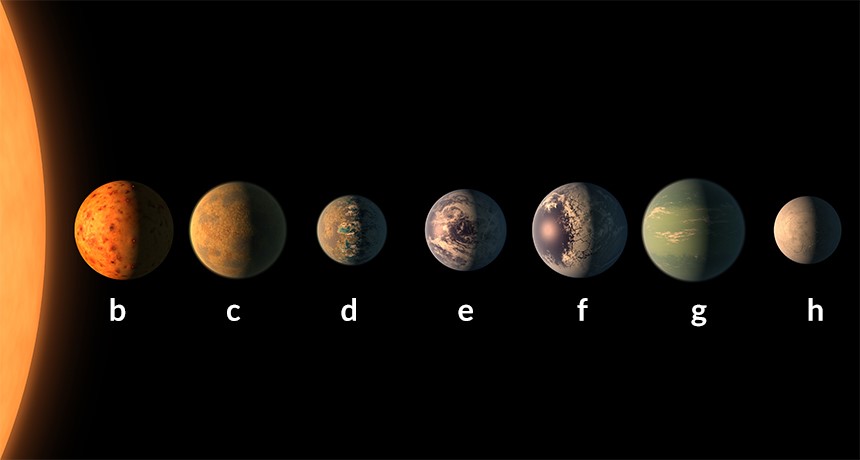09 March 2017
By: Dr. Omar Fikry
Head, Planetarium Section, BA Planetarium Science Center
Once NASA have announced the discovery of a new solar system with 7 Earth-like planets orbiting it, all the international newspapers, websites, and social media started analyzing and explaining this huge discovery. In this article, I will tackle this topic concisely.
Scientists are working hard to answer the famous question “Are we alone in this universe? Is there other life existing elsewhere? Are there other creatures other than us?” Lately, the number of the discovered solar systems has increased to nearly 600 solar systems or more. A solar system here refers to a star with planets orbiting it. Scientists discover these planets through studying the spectrum of these stars using Earth telescopes or satellites or simply by observing the change in the light omitting from the star of the newly discovered solar system.
On Wednesday, 22 February 2017, the website of the famous magazine Nature announced some important news that a new solar system was discovered; this solar system consists of a star and seven Earth-like planets orbiting around it. The star named Trappist is in the constellation Aquarius and is around 39 light years (376 trillion kilometers) away from Earth. Trappist was discovered by NASA’s Spitzer Space telescope which rotates around Earth. The seven planets of this newly discovered solar system are located in a zone that can support life. This zone is called habitable zone which is a region where the planets are located in a good distance away from the star and the temperature and atmospheric conditions are suitable for life on these planets. The following table summarizes the specifications of these 7 planets:
| Planet's Name |
Length of the Day |
Distance from the Parent Star (Astronomical Unit) |
Radius (Earth's Radius) |
Mass (Earth's Mass) |
| Trappist-1b |
1.5 |
0.011 |
1.09 |
5.35 |
| Trappist-1c |
2.42 |
0.015 |
1.06 |
1.38 |
| Trappist-1d |
4.05 |
0.021 |
0.77 |
0.41 |
| Trappist-1e |
1.6 |
0.028 |
0.92 |
0.62 |
| Trappist-1f |
9.21 |
0.037 |
1.04 |
0.68 |
| Trappiust-1g |
12.35 |
0.045 |
1.13 |
1.34 |
| Trappist-1h |
20.1 |
0.06 |
0.76 |
Unknown |
The seven planets were discovered through studying the change of their movement in front or behind the parent star. Scientists confirmed that the seven planets consist of an atmosphere that is similar to that of planet Earth. Moreover, the first six planets are rocky planets which is close to the rocky nature of Earth to some extent. What is strange about these planets is that the length of the day on these seven planets equals 1 year on Earth; this means that the time consumed during the rotation of the planet around the parent star is equal to the time it takes while rotating around itself. That is why the side facing the star is perpetual day while the other side is perpetual night. This discovery urged scientists to do further studies and observations to make sure of these data and to study the components of the atmosphere; does their atmosphere contain oxygen or not? Is there water on their surface? What is the weather conditions on these planets? In addition to other studies to measure the intensity of gravity on them.
NASA scientists and the discovery team hope to use the new James Webb Space telescope, which will be launched in 2018, in their precise studies of the atmosphere of these seven planets. We are now just a few steps away from answering the famous question “Is there other life in the universe? Are there any creatures living somewhere else other than planet Earth?”

(An imaginary picture of the new solar system Trappist and its Earth-Like planets – Source NASA)